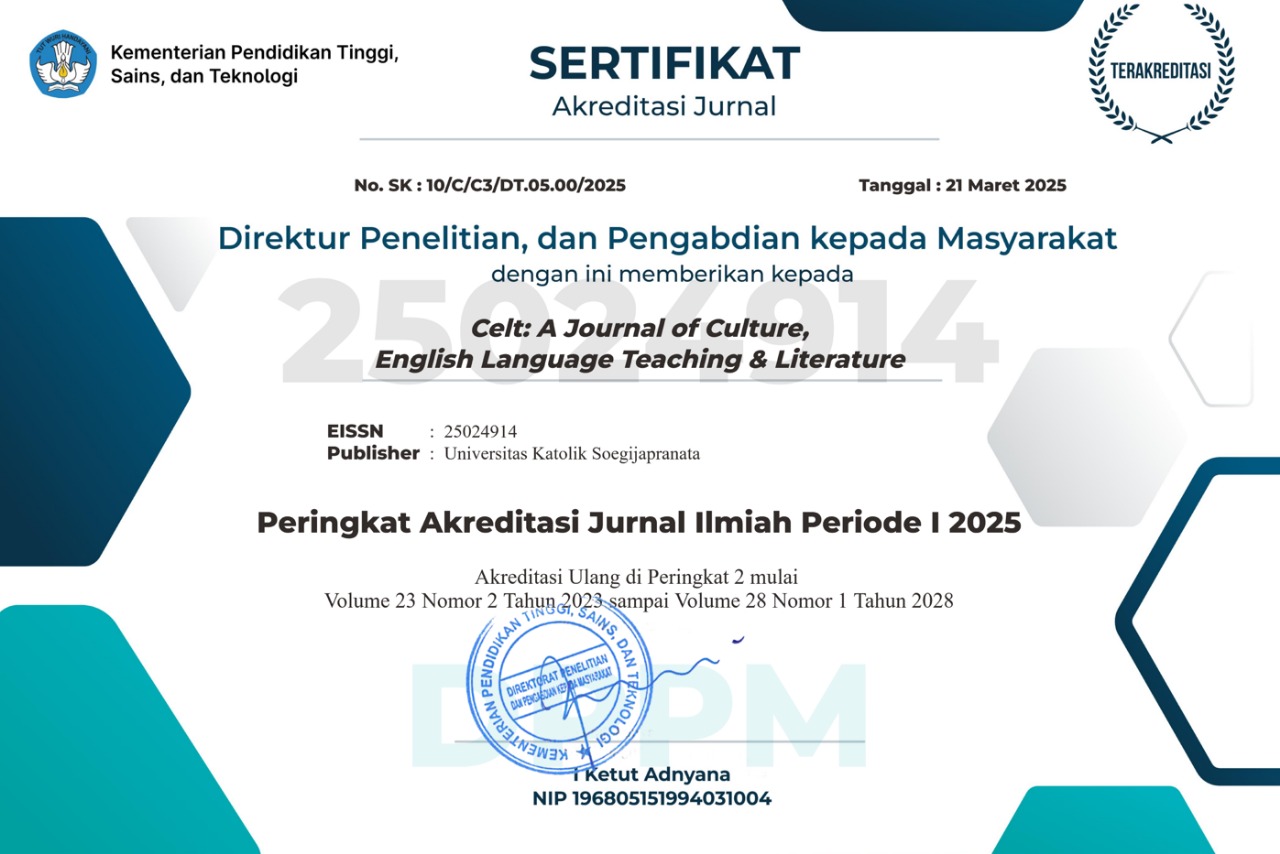Direct and Indirect Compliment Responses: A Descriptive Qualitative Study among Indonesians and Americans
Abstract
Keywords
Full Text:
PDFReferences
Allami, H., & Montazeri, M. (2012). A Sociopragmatic Analysis of Compliment Responses in Persian. Iranian Journal of Applied Lkanguage Studies, 4(1), 1–38. Retrieved from http://ijals2.usb.ac.ir/article_1346_235.html
Annatius, V. (2005). A PRAGMATIC ANALYSIS OF COMPLIMENTS IN ZULU by. (December).
Austin, J. L. (1962). How to Do Things with Words: Second Edition. In Oxford At the Clarendon Press. https://doi.org/10.1093/acprof:oso/9780198245537.001.0001
Barkindo, S., Partial, I. N., Of, F., Language, E., & Studies, L. (2013). a Pragmatic Analysis of Compliments in Hausa Social Contexts By the Requirements for the Award of Master ’ S Degree in.
Blum-kulka, S., & Olshtain, E. (1984). Requests and apologies: A cross-cultural study of speech act realization patterns (CCSARP). Applied Linguistics. https://doi.org/10.1093/applin/5.3.196
Brown, P., & Levinson, S. C. (1988). Politeness: Some Universals in Language Usage (Studies in Interactional Sociolinguistics 4). TESOL Quarterly, 22(4), 660. https://doi.org/10.2307/3587263
Falasi, H. Al. (2007). Just say Thank you : A study of compliment responses. The Linguistics Journal, 2(1), 28–42.
Fujimura-wilson, K. (1991). A Cross-Cultural Study of Compliments and Compliment Responses in Conversation. 19–36.
Geert hofstede, Gert Jan Hofstede, M. M. (2010). Cultures and Organizations. In Cultures and Organizations. https://doi.org/10.1007/s11569-007-0005-8
Golato, A. (2002). German compliment responses. Journal of Pragmatics. https://doi.org/10.1016/S0378-2166(01)00040-6
Herbert, R. (1988). The ethnography of English compliment and compliment responses. https://doi.org/10.1075/pbns.3.05her
Herbert, R. K. (1990). Sex-based differences in compliment behavior. Language in Society. https://doi.org/10.1017/S0047404500014378
Holmes, J. (1986). Compliments and Compliment Responses in New Zealand English. Anthropological Linguistics.
Holmes, J. (1988). Paying compliments: A sex-preferential politeness strategy. Journal of Pragmatics. https://doi.org/10.1016/0378-2166(88)90005-7
Kochman, T. (1981). Black and White Styles in Conflict. Chicago: The University of Chicago Press.
Lorenzo-Dus, N. (2001). Compliment responses among British and Spanish university students: A contrastive study. Journal of Pragmatics. https://doi.org/10.1016/S0378-2166(99)00127-7
Maulida, N. (2019). TINDAK TUTUR MEMUJI DALAM FILM KAZE TACHINU. LITE, 15 nomor 1, 17.
Muhammad, A. A. (2013). KESADARAN HUKUM MASYARAKAT KAMPUNG MAHMUD UNTUK MEMILIKI SERTIFIKAT ATAS HAK ULAYAT: Studi Kasus di Kampung Adat Mahmud Desa Mekarrahayu Kecamatan Marga Asih Kabupaten Bandung. Universitas Pendidikan Indonesia.
Nobuyuki honna; Bates Hoffer. (1989). An english dictionary of japanese ways of thinking. Tokyo: Yuhikaku Publishing Co.
Pomerantz, A. M. (1978). Compliment responses: Notes on the co-operation of multiple constraints. In Studies in the organization of conversational interaction.
Rachman, A. K., & Kinanti, K. P. (2018). Respon Pujian Oleh Mahasiswa Multikultural (Studi Kasus dengan Tinjauan Sosiopragmatik). Belajar Bahasa: Jurnal Ilmiah Program Studi Pendidikan Bahasa & Sastra Indonesia, 3(1).
Razi, N. (2013). A Contrastive Study of Compliment Responses among Australian English and Iranian Persian Speakers. Procedia - Social and Behavioral Sciences. https://doi.org/10.1016/j.sbspro.2013.01.038
Refnaldi. (2009). Transfer Pragmatik Dalam Respon Terhadap Pujian Dari Bahasa Indonesia Ke Dalam Bahasa Inggris. Linguistik Indonesia.
Sacks, H., & Schegloff, E. (1973). Opening up closings. Semiotica.
Searle, J. R. (1976). A classification of illocutionary acts. Language in Society. https://doi.org/10.1017/S0047404500006837
Thomas, J. (1983). Cross-cultural pragmatic failure. Applied Linguistics. https://doi.org/10.1093/applin/4.2.91
Vaneva, M., & Ivanovska, M. (2018). Pragmatics of English Speech Acts: Compliments Used by Macedonian Learners. International Journal of English Linguistics, 8(5), 272. https://doi.org/10.5539/ijel.v8n5p272
Wierzbicka, A. (2003). Cross-Cultural Pragmatics: The Semantics of Human Interaction. In Language (2nd ed., Vol. 72). https://doi.org/10.2307/416282
Wolfson, N., & Manes, J. (1980). The compliment as a social strategy. Paper in Linguistics. https://doi.org/10.1080/08351818009370503
DOI: https://doi.org/10.24167/celt.v20i1.2655
Copyright (c) 2020 Celt: A Journal of Culture, English Language Teaching & Literature
| pISSN (print): 1412-3320 | eISSN (online): 2502-4914 |











